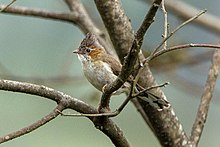
Mahananda Wildlife Sanctuary is located on the foothills of the Himalayas, between the Teesta and Mahananda rivers. Situated in the Darjeeling district of West Bengal, India; it comes under Darjeeling Wildlife division and can be reached from Siliguri in 30 minutes. Sukna, the gateway to the sanctuary, is only 13 km from Siliguri and 28 km from Bagdogra airport. The sanctuary sprawls over 159 km2 of reserve forest and was started as a game sanctuary in 1955. In 1959, it got the status of a sanctuary mainly to protect the Indian bison and royal Bengal tiger, which were facing the threat of extinction.

Neora Valley National Park is a national park in Kalimpong district, West Bengal, India that was established in 1986. It spreads over an area of 88 km2 (34 sq mi), and is a rich biological zone in eastern India. It is the land of the red panda in the pristine undisturbed natural habitat with rugged inaccessible hilly terrain and rich diverse flora and fauna. It is linked to Pangolakha Wildlife Sanctuary of Pakyong District as well as forests of Samtse District, Bhutan via thick cover of forests.

The rusty-fronted barwing is a species of bird in the laughingthrush family, Leiothrichidae.

The white-hooded babbler is a species of bird in the family Pellorneidae.

The fire-tailed myzornis is a bird species. Its genus Myzornis is monotypic, and has recently been placed in the family Paradoxornithidae.
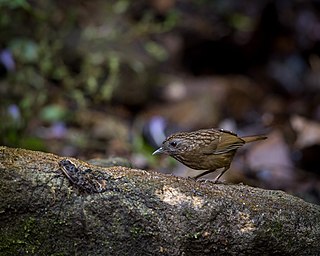
The streaked wren-babbler is a species of bird in the family Pellorneidae. It is found in Bangladesh, Cambodia, China, India, Laos, Malaysia, Myanmar, Thailand and Vietnam. Its natural habitats are subtropical or tropical moist lowland forest and subtropical or tropical moist montane forest.
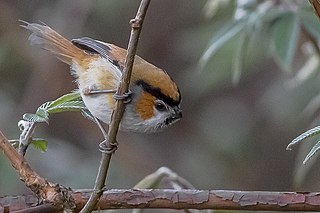
The black-throated parrotbill is a parrotbill species often placed with the Old World babblers or in a distinct family Sylviidae, but it actually seems to belong to the distinct family Paradoxornithidae.

The Red-billed Scimitar-Babbler is a species of bird in the family Timaliidae. It is found in Northeast India, Southeast Asia and adjacent parts of southern China. It has a long reddish-orange decurved bill that is typical of Scimitar-Babblers, a rather long white supercilium, and brown upperparts and tail. Sexes are similar.

The white-browed scimitar babbler is a species of bird in the family Timaliidae. It is found in Bangladesh, Bhutan, Cambodia, India, Laos, Myanmar, Nepal, Thailand, and Vietnam. Its natural habitats are subtropical or tropical moist lowland forest and subtropical or tropical moist montane forest.
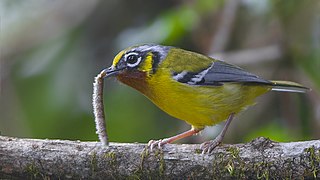
The black-eared shrike-babbler is a bird species in the vireo family, Vireonidae. It was traditionally considered as an aberrant Old World babbler and formerly placed in the family Timaliidae. It was long noted that their habits resembled those of vireos, but this was previously ascribed to the result of convergent evolution. It is found in Southeast Asia from the Himalayas to western Malaysia. Its natural habitat is subtropical or tropical moist montane forests.

The white-naped yuhina is a bird species in the white-eye family Zosteropidae.
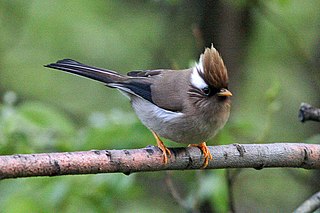
The white-collared yuhina is a bird species in the white-eye family Zosteropidae.

The whiskered yuhina is a bird species in the white-eye family Zosteropidae. Its range extends across the Himalayan forests in northern India to northeast Indian states, Nepal, Bhutan, Bangladesh and in the east to Indochina including Laos, Myanmar, Thailand, and Vietnam. Its natural habitat is subtropical or tropical moist montane forests. The whiskered yuhina is sometimes found in mixed hunting parties with other yuhina and fulvetta species, but it has also been reported to not associate with mixed hunting parties in some areas. It is described as one of the commonest yuhinas in the Himalayas, although it is relatively uncommon to rare at low elevations. It prefers relatively undisturbed closed canopy cover. It is one among several other birds hunted by livestock herders in Northeast India.

The stripe-throated yuhina is a bird species in the white-eye family Zosteropidae.

The Burmese yuhina is a species of bird in the family Zosteropidae. It is found in Myanmar and Thailand. Its natural habitat is subtropical or tropical moist montane forests.

The black-chinned yuhina is a bird species in the white-eye family Zosteropidae.

The rufous-vented yuhina is a bird species in the white-eye family Zosteropidae. It is found along the northern parts of the Indian subcontinent, primarily in the Eastern Himalayas, and ranges across Bhutan, India, Tibet, Myanmar, and Nepal. Its natural habitat is subtropical or tropical moist montane forests.

The white-bellied erpornis or simply erpornis is a species of bird. It is the only member of the genus Erpornis. This bird is found in Bangladesh, Bhutan, Brunei, Cambodia, China, India, Indonesia, Laos, Malaysia, Myanmar, Nepal, Singapore, Taiwan, Thailand, and Vietnam. Its natural habitat is subtropical or tropical moist montane forests.
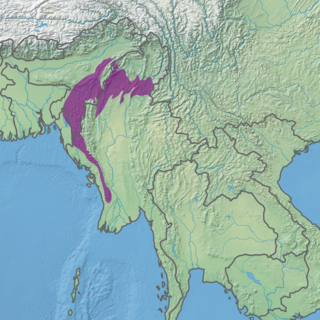
The Mizoram–Manipur–Kachin rain forests is a subtropical moist broadleaf forest ecoregion which occupies the lower hillsides of the mountainous border region joining India, Bangladesh, and Burma (Myanmar) and China's Yunnan Province. The ecoregion covers an area of 135,600 square kilometres (52,400 sq mi). Located where the biotas of the Indian Subcontinent and Indochina meet, and in the transition between subtropical and tropical regions of Asia, the Mizoram–Manipur–Kachin rain forests are home to great biodiversity. The WWF rates the ecoregion as "Globally Outstanding" in biological distinctiveness.
Pangolakha Wildlife Sanctuary is a wildlife reserve in the Pakyong District of the state of Sikkim in India. It is about 28 kilometres (17 mi) east of Rorathang and about 40 kilometres (25 mi) by road from Rangpo city. The total notified area of the park is around 124 square kilometres (48 sq mi) while inside the wildlife sanctuary there are a few hamlets: Aritar, Dakline Lingtam, Phadamchen, Dzuluk, Gnathang Monastery Kupup. This wildlife sanctuary is linked to the forests of Neora Valley National Park of West Bengal as well as forests of Samtse, Bhutan and Haa district Bhutan. The area that comes under this biosphere has been declared in 1999 as a wildlife sanctuary under biogeographic province category 2C.
